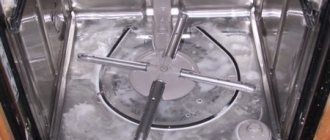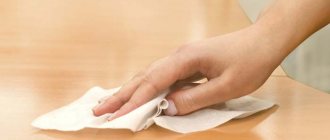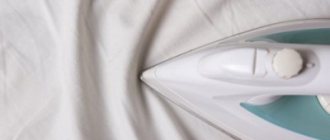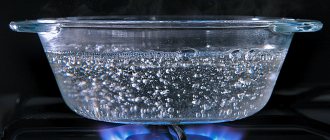Why did the meat grinder turn dark?
First you need to understand why the meat grinder has darkened. The reason will allow you to find out whether it can be washed. Without knowledge in the field of chemistry it is impossible to understand this. The thing is that the metal from which the device is made reacts with a detergent dissolved in hot water. Most meat grinders are made of aluminum alloy, which interacts well with many substances, even water.
Conditions are created inside the dishwasher that speed up interaction processes. To make it suitable for use, a special oxide film is created on the surface of an aluminum device, which prevents the metal from deteriorating. But this film itself is easily destroyed under the influence of strong alkalis, which is what happens in the dishwasher. With prolonged contact with hot water, the metal begins to darken.
For your information! Some old meat grinders are made of cast iron and may not darken when washed in a PMM. But you shouldn’t wash them this way, as cast iron will begin to rust over time.
The most important thing is that the scary thing is not that the meat grinder has oxidized and become covered with a dark coating, but that the metal has undergone partial destruction. It can enter the human body. Scientists have long been talking about its negative effects on internal organs. Therefore, we draw your attention once again, do not violate the rules for operating equipment, do not wash aluminum dishes in the dishwasher, and you will find a complete list of such dishes in the article What dishes cannot be washed in a PMM?
Laundering methods
It is impossible to say unequivocally whether it is possible to wash a meat grinder after using a dishwasher. Firstly, everything will depend on the degree of darkening and oxidation of the metal, and secondly, it is important what alloy the device is made of. Even aluminum can be different. Therefore, you should not immediately despair, trusting the words on the forums that the black film is sodium tetrahydroxyaluminate, which cannot be dissolved at home. It may be impossible to dissolve, but who forbids physically cleaning it?
We will not rack our brains with complex chemical names and conduct dangerous experiments, but will try available means that have been tested by experience. It will help some, it won’t help others, the main thing is that it won’t get worse. Let's list these means:
- Baking soda. You need to pour it onto the damp surface of the meat grinder and rub it with a metal brush. After several such cleanings, the coating will come off and the smearing will stop, but the metal will not shine. Just don’t boil the meat grinder in a soda solution, you’ll make it even worse.
- Soap. Rub the darkened parts with a brush for a long time using soap.
- GOI paste for final polishing. You need to apply the paste to a felt cloth and rub off the dark spots with force.
- Dialux polishing paste.
- Rust converter HORS. This product is intended for cars, so you should only use it to clean the meat grinder as a last resort, after you’ve tried everything.
Important! Such improvised means as acetic and citric acid should not be used when cleaning the meat grinder after washing it in the dishwasher; they are weak and are unlikely to help.
Some tips from housewives
After washing the meat grinder in the dishwasher, housewives immediately begin to look for ways to clean the damaged device, sharing their experience. We read not a single review, but here are some valuable tips we found:
- Brush with toothpaste and brush. True, a man washed a damaged meat grinder in this way, apparently using good physical strength.
- Use the product “Shining Shine of Metals” from the Italian company CENTRALIN. My husband had to scrub the frying pan again using abrasive brushes. He dealt with all the spare parts in 20 minutes.
- Try JIF together with a wire brush. As mother and son assure, they managed to restore the shine to the meat grinder, but some minor scratches remained.
! When washing the meat grinder, wear gloves to protect the skin of your hands from gray deposits and the harmful effects of all substances used.
- Soak in Sprite or Coca-Cola. How much it helps is unknown, since the woman did not share the result.
- Wash with Sanitol Steel Shine and then polish, for example, with Biolan. The method is effective and affordable.
- Soak in hot water with tar soap. As the woman writes, everything comes off on its own, you don’t even have to rub it.
That's about all we managed to find. Of course, there are also chemical methods, but they are not safe, so we will not describe them. It’s better to remember and tell everyone that you can’t wash the meat grinder in the PMM, no matter how much you want to. Good luck!
Tips from housewives
Many experienced housewives, faced with the problem of a meat grinder darkening after a dishwasher, often share their knowledge on the Internet. One of the most popular means for cleaning a meat grinder from plaque is the “Shining Shine of Metals” product from CENTRALIN. After applying it to the surface, scrub with abrasive brushes. If the plaque is difficult to clean, the whole procedure will take you about twenty minutes, provided that all parts are wiped off from the plaque.
You can also use a metal brush, but it will leave scratches on the surface.
Important! When cleaning the meat grinder, wear rubber gloves to avoid contact of harmful substances with your skin.
- Among the most popular is also the product “Sanitol Shine of Steel”. After rubbing the meat grinder with it, it is recommended to polish it. Any of the leading cleaning powders will do.
- Housewives also advise soaking the meat grinder in hot, but not boiling water, first diluting it with tar soap.
It is not recommended to use iron sponges unnecessarily, as they can damage the surface, leaving scratches and thereby accelerating corrosion. Try to use hard sponges that do not scratch the surface, i.e. felt sponges.
Important! When a scratch appears on the surface, there is a high probability of corrosion spots appearing. Try to take this circumstance into account when cleaning meat grinders.
Some housewives even recommend such an unusual cleaning method as toothpaste. Due to its purpose for sensitive and fragile tooth enamel, this substance acts delicately on the surface without damaging the protective film. True, this method does not always work. You may end up wasting your time and toothpaste, so we advise you to practice this option only as a working option.
Why did the meat grinder turn dark?
After immersion and washing in the dishwasher, 9 out of 10 meat grinders become unsuitable for further use. Shiny parts darken, oxidize, the alloy becomes covered with a dark sticky coating, and the grinded products deteriorate. This is due to the fact that in a dishwasher the water temperature varies from 45 to 90 degrees, and cleaning occurs with the help of special substances.
Aluminum enters into a chemical reaction upon contact with alkali and boiling water. Under this action, the protective oxide film covering the parts is destroyed. Without the film, the meat grinder begins to darken and oxidize upon contact with oxygen and food. A darkened meat grinder quickly corrodes.
Aluminum meat grinders should not be washed in the dishwasher. The stainless steel meat grinder with titanium coating tolerates cleaning well in the dishwasher.
What other items cannot be washed in the dishwasher:
- dishes containing cupronickel or silver;
- cast iron frying pans;
- crystal and porcelain products;
- wooden boards;
- plastic dishes.
Is it possible to wash the meat grinder in the dishwasher?
The process of washing a manual or electric meat grinder is practically the same. First of all, the device is disassembled into parts, then the remaining food is removed and washed with warm water using cleaning products. Naturally, the body of the electrical unit, which contains the elements of the electrical circuit, is prohibited from being immersed in water. The removable parts of the meat grinder require careful cleaning, so in order to save time, many housewives put them in the dishwasher.
However, the problem is not only that the surface takes on an unsightly appearance. Experts say that continued use of the unit in this condition will lead to rapid food spoilage and food poisoning. Metal particles entering the human body provoke diseases of the upper respiratory tract, damage to the nervous system, and tend to accumulate in the bones. Why does this effect occur and what should the housewife do?
How to wash dishes in the dishwasher - 5 golden rules
The first mechanized dishwasher went on sale in 1886. American Josephine Cochrane said to herself “I am a woman, not a dishwasher!” (more precisely: “If nobody else is going to invent a dishwashing machine, I'll do it myself!”) and invented the dishwasher.
In the 1950s, compact dishwashers suitable for home use began to be sold. Since then, this household appliance has been a typical “resident” in American kitchens, along with a refrigerator or coffee maker.
In our country, dishwashers have long been considered an unaffordable luxury. But in recent years, more and more people are realizing their advantages (saving time, quality of washing).
From this article you will learn how to properly wash dishes in a dishwasher, as well as what to do to ensure that the appliance serves you for many years.
Dishwashers come in floor-standing (free-standing or built-in) and countertop (compact) types. Floor-standing dishwashers are also divided into “narrow” (45 cm wide, for 9-13 sets) and “full-size” (60 cm wide, for 7-16 sets).
A set is a set of dishes for one person (tureen, flat plate, saucer, mug, cutlery).
In addition, dishwashers differ in operating modes, type of load, efficiency of water and electricity consumption and other parameters.
But regardless of the brand of dishwasher, there are general rules for its operation. Let's get acquainted with the main ones.
Rule No. 1 – Place dishes inside the machine correctly
As a rule, modern dishwashers are equipped with 2 baskets for loading dishes. The lower one is intended for large items (pots, pans, large dishes). The top one is for tableware (plates, cups, etc.). Spoons, forks, knives and other cutlery are usually placed in a special tray that comes with the machine or is sold separately.
To optimally place dishes inside the machine, start loading from the lower basket. Place large plates on the edges, small ones closer to the center. There, in the middle, place a tray with cutlery (if there is none, still put the forks and spoons in the center).
The dishes should not interfere with the rotation of the machine's rocker arms. Therefore, do not place pans and other items with long handles vertically.
Water in the dishwasher is usually supplied from the bottom up, so place hollow items (mugs, plates, cups) upside down. Do not lay them on their sides - water and detergent will remain. In addition, it is not recommended to stack objects on top of each other.
Do not overload the machine. And if the dishes are very dirty, then it is better to place the plates not in each cell of the basket, but every other.
But the most important thing to remember is which dishes can be washed in the dishwasher and which cannot.
What should not be washed in the dishwasher: • old cracked or stuck together dishes; • wooden objects (cutting boards, knives with wooden handles, etc.); • objects made of rusting steel, copper and tin; • non-heat-resistant dishes (glass and plastic).
What is not recommended to wash in the dishwasher: • silver and aluminum items (or only using special detergents and washing programs); • crystal dishes (or only with special products and gentle washing modes); • earthenware (if the detergent and washing program are selected incorrectly, the glaze and designs may fade).
At the end of the wash cycle, wait 10-15 minutes for the dishes to cool. If you take out the dishes right away, you can get burned. In addition, hot dishes break more easily.
Do not use the dishwasher as a washing machine. Do not wash kitchen towels, sponges or other utensils in it.
Rule No. 2 – choose the right washing mode
A standard dishwasher cycle includes pre-wash (rinsing off food residues with cold water), wash (directly washing with hot water using detergent), rinse (rinsing off detergent) and drying.
In addition, in dishwashers there are such programs as intensive washing (very high t? - up to 75 degrees), a program for fragile dishes (water t? - from 30 to 40 degrees), quick wash (when you need to rinse dishes after liquid food and immediately after eating) and others.
The program you choose (washing time and temperature) must correspond to the type of dishes and the degree of soiling.
In addition, dishwashers of the middle and highest price categories have a “pre-soak” function. But it is much easier and more economical to manually clean off dried-on food residues from them before loading the plates into the machine. The same thing with “burnt” pots and pans.
Rule #3 – Use the right detergents
Dishwashers use special detergents.
Do not use regular dishwashing gels and powders.
Dishwasher detergents can be divided into two types - powder and tablets.
Powders are more common. On average, its consumption per 1 dishwasher cycle is 25-30 grams.
Tablets are considered more convenient. They are single-layer, multi-layer and combined. The latter are considered the most practical, as they combine detergent components, rinse aid and regenerating salt. If your car model allows for the use of such products, you will not have to buy three different substances.
The consumption of tablets is approximately 1 tablet per 1 cycle.
It is not recommended to use tablet detergents in gentle washing programs - the tablet does not have time to dissolve.
Based on their properties, dishwashing detergents can be divided into strongly alkaline and weakly alkaline (usually with enzymes). Enzymes are biological enzyme additives that break down proteins, fats and polysaccharides that make up contaminants. Enzyme products are usually used to wash fragile dishes.
Bigger doesn't mean cleaner. Use as much detergent as directed in the instructions.
In addition, unless there are special instructions on the packaging, you should not wash fragile or silverware with it.
In addition to detergent, to use your dishwasher effectively, you need rinse aid. It removes detergent residue, adds shine to dishes and helps them dry quickly. Rinse aid consumption is approximately 0.5-0.7 liters for 10-12 cycles.
Rule No. 4 – watch the water hardness
The cleanliness of dishes washed in the dishwasher also depends on the hardness of the water. Hard water leaves white streaks on dishes.
In most cases, water softening is required for the machine to function properly. For this, regenerating salt is used. Usually the capacity for it in cars is quite large - 1-2 kg. It lasts long enough.
In addition, lime from hard water settles on the heating elements of the machine, which can cause damage. Therefore, salt is also necessary to protect the device.
Rule #5 – Take care of your dishwasher
Any technique loves care. Dishwashers are no exception. If you want your machine to serve you for a long time, follow these recommendations.
Clean the filter from time to time (washed-out food residues settle on it). Also wash the dish baskets regularly (they are usually easy to remove).
Use additional dishwasher care products. So, every 15-20 cycles it is recommended to use a degreaser (powder or gel product). It helps remove accumulated grease from the inside of the machine.
Also, give your car “prevention” 2-4 times a year. To do this, you can use a special product or regular citric acid. Pour anti-scale into the dispenser and turn on the unloaded machine on a standard cycle.
Finally, at least once a week, wipe the dishwasher with a damp cloth, inside and out, not forgetting the door seal.
Cleaning the meat grinder using laundry soap
For a meat grinder and its accessories, as for any other type of utensil, sometimes soaking in a soapy solution may be enough. Heat regular tap water and sprinkle in a few drops of liquid soap or any cleaning product.
Liquid laundry soap has a universal scope of application. It can be used for hand washing and soaking clothes, and for washing floors. In addition, liquid soap does not corrode the skin and you can work with it without rubber gloves. In addition, the soap does not contain aggressive reagents and interacts well with all fragile surfaces without damaging the meat grinder or leaving scratches on its surface. Its formula does not react chemically with the aluminum body of the meat grinder and does not destroy the protective film.
Design of a manual meat grinder
Almost every kitchen has an old, reliable mechanical meat grinder. Based on its analogue, products with an electric drive were created, that is, similar parts are present in both one and the other model. To properly assemble a meat grinder, you need to know its design. So it consists of:
- One-piece body . Old copies were made of cast iron; later they began to produce cases made of aluminum alloys. There is a neck in the upper part of the body into which products for grinding are placed.
- Auger . A spiral element that moves products towards the exit.
- Knife . Performs rotational movements and is put on the end of the auger. It can be with wings or in the form of a disk.
- Lattices . Provides grinding of products. When making cookies and other baked goods from dough, special shaped elements are inserted instead of a lattice.
- Clamping device . The round element securely fixes all parts of the device. For ease of fastening, special protrusions are made on its surface.
- Handles and screws . On the reverse side of the structure there is a handle through which the mechanism rotates. It is secured with a screw.
The meat grinder is installed on a table or other horizontal surface and secured with a threaded element. If necessary, some material is placed under the base to ensure reliable fixation of the machine and prevent its movement during operation.
In order for the device to work perfectly, when assembling the structure, it is important to ensure that all actions are correct.
Rules for caring for a manual meat grinder
A mechanical meat grinder is a necessary tool in any kitchen, but you don’t need to use a dishwasher to clean it. After cooking, you will have to take a little time to clean it and prepare it for further use. To do this we proceed as follows:
- When finished using the device, it should be immediately disassembled and washed. Otherwise, the surface will be susceptible to oxidation.
- We remove food residues from knives and other parts using a stiff brush. The grate can be cleaned with a toothpick.
- We wash all parts in warm water.
- Apply a little non-aggressive dish soap to a sponge and process all the parts. If necessary, you can wipe the surface with baking soda and a brush.
- Rinse everything thoroughly and treat with boiling water.
- We wipe clean parts with a cotton towel or napkin and send them to a dry, warm place for final drying. If the meat grinder is not dried, then rust will form on it.
- We assemble the device, place it in a fabric bag or wrap it in paper and store it in a dry place.
A meat grinder is usually used to grind raw foods. Some of them may contain harmful microorganisms that, when entering the human body, cause irreparable harm. That is why high demands are placed on the sanitary treatment of the meat grinder and all surfaces in contact with meat.
If you are not sure of the high quality of the meat, then additionally treat the meat grinder with saline solution. It is prepared from water and salt: half a spoon of salt is dissolved in one liter of boiled water. The machine is immersed in a container with the solution in a disassembled, clean form; the processing time is about 15 minutes.
These simple recommendations will help restore a well-groomed appearance to your kitchen unit. At the same time, do not forget that repeated cleaning in the dishwasher may be the last. Therefore, for products that require special care, we prefer manual washing instead of automatic washing.
Instructions
Never wash meat grinders in the dishwasher: neither mechanical nor electric. If you like home-made minced meat, then after cooking you will have to spend a few minutes washing the device to grind it. Stock up:
- sponge;
- soap and soda;
- an old toothbrush;
- a plastic bowl;
- cotton towel;
- canvas bag.
READ MORE: The washing machine constantly takes in water, what to do and how to fix it, reasons and rules for fixing
Now start washing:
- Immediately after completing the work, disassemble the device, otherwise the oxidation process will start.
- Remove any remaining meat or other grinding product from knives and other parts. To do this, use a stiff kitchen brush.
- Rinse all elements with warm water. After lathering the sponge with regular soap that does not contain dyes or fragrances, rub the parts. You can sprinkle baking soda on the sponge or use an old toothbrush.
- Rinse the washed parts with warm water and then pour boiling water over them.
- Place in a plastic container - water should drain from the washed parts.
- When the water has drained, wipe all components with a cotton napkin and lay them out to dry. The drying surface must be clean and dry. Such actions prevent the appearance of rust.
- After assembling the meat grinder, place it in a canvas bag and place it in a dry place.











